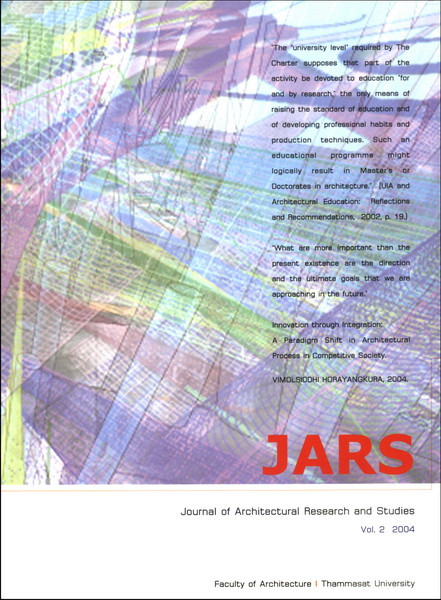Fractal Geometry in Architecture and Urban Planning
Main Article Content
Abstract
The radical shift from the classical paradigm of science to a new paradigm, which is based on the science of complexity, has affected human knowledge and an understanding of life at all levels. It has led to the great breakthroughs of humanity both in social and cultural aspects. One of the significant effects, for instance, is the profound change of knowledge in Mathematics and Geometry which is long time rooted in the system of ‘Euclidean Geometry’
The science of complexity has brought about a new system of geometry called ‘Fractal Geometry’ since the beginning of the 20th century. Fractal Geometry has changed human ideas, perception and an understanding of both living systems and natural phenomena. It becomes a systematic explanation and an analytical tool for irregular both living and non-living things found in nature. Fractal Geometry contains structures or patterns whose smaller part is a miniature version of its larger form. This ‘self-similarity’ reflects the relation between the patterns seen in parts and the patterns seen in that of the whole.
Fractal Geometry not only provides the mathematicians and scientists with a new tool to explore nature, but
also influences the creation of arts, architecture and even urban morphology. The employment of Fractal Geometry in
architectural design has been manifested in the planning of buildings, external forms, spatial dimension and ornaments
on building skins. In urban planning, it assists to explain the complex growth and internal organizations of cities.
Downloads
Article Details

This work is licensed under a Creative Commons Attribution-NonCommercial-NoDerivatives 4.0 International License.
All material is licensed under the terms of the Creative Commons Attribution 4.0 International (CC-BY-NC-ND 4.0) License, unless otherwise stated. As such, authors are free to share, copy, and redistribute the material in any medium or format. The authors must give appropriate credit, provide a link to the license, and indicate if changes were made. The authors may do so in any reasonable manner, but not in any way that suggests the licensor endorses you or your use. The authors may not use the material for commercial purposes. If the authors remix, transform, or build upon the material, they may not distribute the modified material, unless permission is obtained from JARS. Final, accepted versions of the paper may be posted on third party repositories, provided appropriate acknowledgement to the original source is clearly noted.


